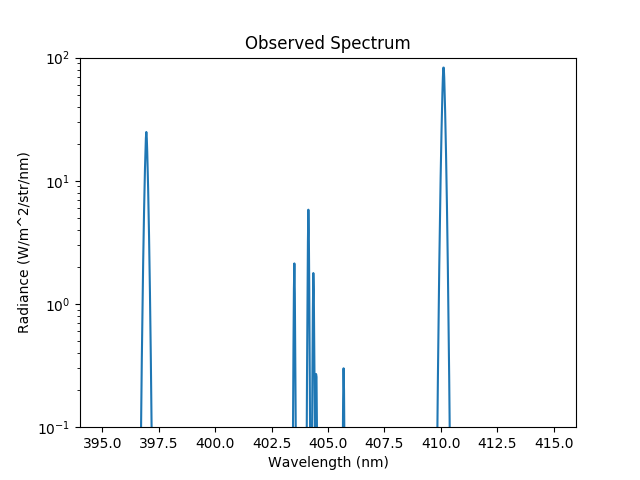Multiplet Line Ratios¶
Some lines split into multiple components, requiring a higher spectroscopy resolution than is normally modelled in Cherab. It is possible to add the experimentally measured multiplet ratios by using the MultipletLineShape() class. The ratios between the multiplet lines will be constant, but the total emissivity of the multiplet will match the original emissivity as specified by your atomic data.
In this example we specify a Nitrogen II multiplet using experimental line ratios from Table I of the paper: Henderson, S.S., et al. “Determination of volumetric plasma parameters from spectroscopic N II and N III line ratio measurements in the ASDEX Upgrade divertor.” Nuclear Fusion 58.1 (2017): 016047.
# Copyright 2016-2018 Euratom
# Copyright 2016-2018 United Kingdom Atomic Energy Authority
# Copyright 2016-2018 Centro de Investigaciones Energéticas, Medioambientales y Tecnológicas
#
# Licensed under the EUPL, Version 1.1 or – as soon they will be approved by the
# European Commission - subsequent versions of the EUPL (the "Licence");
# You may not use this work except in compliance with the Licence.
# You may obtain a copy of the Licence at:
#
# https://joinup.ec.europa.eu/software/page/eupl5
#
# Unless required by applicable law or agreed to in writing, software distributed
# under the Licence is distributed on an "AS IS" basis, WITHOUT WARRANTIES OR
# CONDITIONS OF ANY KIND, either express or implied.
#
# See the Licence for the specific language governing permissions and limitations
# under the Licence.
# External imports
import matplotlib.pyplot as plt
from scipy.constants import electron_mass, atomic_mass
from raysect.optical import World, translate, rotate, Vector3D, Point3D, Ray
from raysect.primitive import Sphere
from raysect.optical.material.emitter.inhomogeneous import NumericalIntegrator
# Cherab imports
from cherab.core import Species, Maxwellian, Plasma, Line
from cherab.core.atomic.elements import deuterium, nitrogen
from cherab.core.model import ExcitationLine, RecombinationLine, MultipletLineShape
from cherab.openadas import OpenADAS
from cherab.tools.plasmas import GaussianVolume
# tunables
ion_density = 1e19
sigma = 0.25
# setup scenegraph
world = World()
# create atomic data source
adas = OpenADAS(permit_extrapolation=True)
# PLASMA ----------------------------------------------------------------------
plasma = Plasma(parent=world)
plasma.atomic_data = adas
plasma.geometry = Sphere(sigma * 5.0)
plasma.geometry_transform = None
plasma.integrator = NumericalIntegrator(step=sigma / 5.0)
# define basic distributions
d_density = GaussianVolume(0.5 * ion_density, sigma*10000)
n_density = d_density * 0.01
e_density = GaussianVolume(ion_density, sigma*10000)
temperature = 1 + GaussianVolume(79, sigma)
bulk_velocity = Vector3D(-1e6, 0, 0)
deuterium_mass = deuterium.atomic_weight * atomic_mass
d_distribution = Maxwellian(d_density, temperature, bulk_velocity, deuterium_mass)
nitrogen_mass = nitrogen.atomic_weight * atomic_mass
n_distribution = Maxwellian(n_density, temperature, bulk_velocity, nitrogen_mass)
e_distribution = Maxwellian(e_density, temperature, bulk_velocity, electron_mass)
d0_species = Species(deuterium, 0, d_distribution)
d1_species = Species(deuterium, 1, d_distribution)
n1_species = Species(nitrogen, 1, n_distribution)
# define species
plasma.b_field = Vector3D(1.0, 1.0, 1.0)
plasma.electron_distribution = e_distribution
plasma.composition = [d0_species, d1_species, n1_species]
# setup the Balmer lines
hydrogen_I_410 = Line(deuterium, 0, (6, 2)) # n = 6->2: 410.12nm
hydrogen_I_396 = Line(deuterium, 0, (7, 2)) # n = 7->2: 396.95nm
# setup the Nitrgon II line with multiplet splitting instructions
nitrogen_II_404 = Line(nitrogen, 1, ("2s2 2p1 4f1 3G13.0", "2s2 2p1 3d1 3F10.0"))
multiplet = [[403.509, 404.132, 404.354, 404.479, 405.692],
[0.205, 0.562, 0.175, 0.029, 0.029]]
# add all lines to the plasma
plasma.models = [
ExcitationLine(hydrogen_I_410),
RecombinationLine(hydrogen_I_410),
ExcitationLine(hydrogen_I_396),
RecombinationLine(hydrogen_I_396),
ExcitationLine(nitrogen_II_404, lineshape=MultipletLineShape, lineshape_args=[multiplet]),
]
# Ray-trace and plot the results
plt.ioff()
r = Ray(origin=Point3D(0, 0, -5), direction=Vector3D(0, 0, 1),
min_wavelength=395, max_wavelength=415, bins=1000)
s = r.trace(world)
plt.plot(s.wavelengths, s.samples)
plt.yscale('log')
plt.ylim(0.1, 100)
plt.xlabel('Wavelength (nm)')
plt.ylabel('Radiance (W/m^2/str/nm)')
plt.title('Observed Spectrum')
plt.show()

Caption: An observed NII multiplet in the region of 402-407nm. The multiplet is surrounded by two brighter hydrogen Balmer series lines.¶